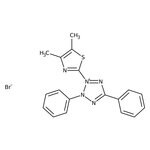Search Thermo Fisher Scientific
Thiazolyl Blue tetrazolium bromide, 98%



Thiazolyl Blue tetrazolium bromide, 98%
Chemical Identifiers
Specifications
Description
This Thermo Scientific Chemicals brand product was originally part of the Alfa Aesar product portfolio. Some documentation and label information may refer to the legacy brand. The original Alfa Aesar product / item code or SKU reference has not changed as a part of the brand transition to Thermo Scientific Chemicals.
Used in measurement of cell proliferation. Produces a yellowish solution that is converted to dark blue, water-insoluble MTT formazan by mitochondrial dehydrogenases of living cells.Thiazolyl Blue tetrazolium bromide is a dye used in measurement of cell proliferation. It is used as a direct indicator of cytotoxicity (such as for screening cancer drugs) and apoptosis. As an electron acceptor, it is utilized for studying nicotinamide adenine dinucleotide phosphate (NADP)-dependent dehydrogenases.
Solubility
Soluble in water, ethanol, 2-methoxyethanol and phosphate buffered saline.
Notes
Light, air and moisture sensitive. Store in a cool place. Keep the container tightly closed in a dry and well-ventilated place. Incompatible with strong oxidizing agents.
Figures
Documents & Downloads
Certificates
Frequently asked questions (FAQs)
Citations & References
Safety and Handling
Classification of the substance or mixture
CLP classification - Regulation(EC) No 1272/2008
Label Elements
Signal Word
Warning
Hazard Statements
H315 - Causes skin irritation
H319 - Causes serious eye irritation
H335 - May cause respiratory irritation
H341 - Suspected of causing genetic defects
Precautionary Statements
P280 - Wear protective gloves/protective clothing/eye protection/face protection
P302 + P352 - IF ON SKIN: Wash with plenty of soap and water
P304 + P340 - IF INHALED: Remove person to fresh air and keep comfortable for breathing
P312 - Call a POISON CENTER or doctor if you feel unwell
P332 + P313 - If skin irritation occurs: Get medical advice/attention
P337 + P313 - If eye irritation persists: Get medical advice/attention